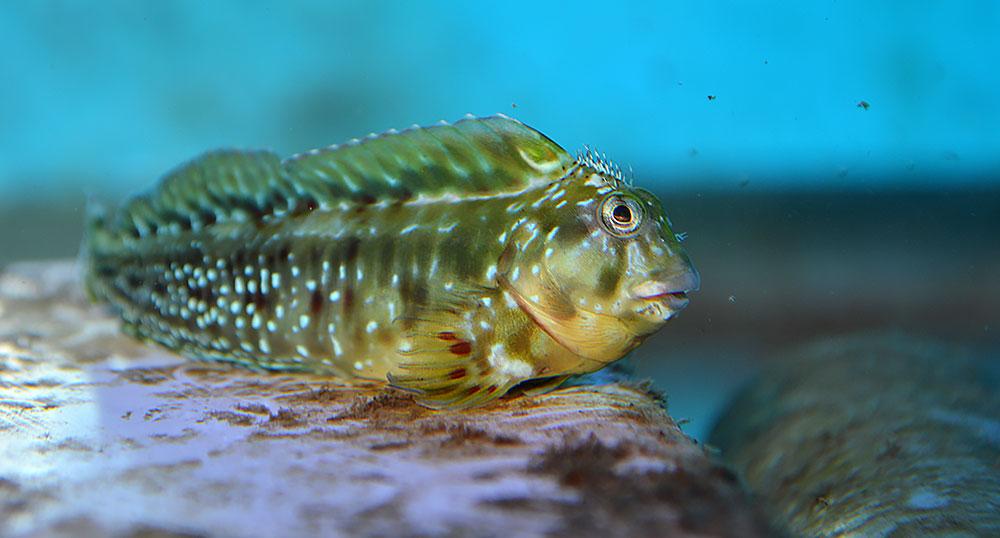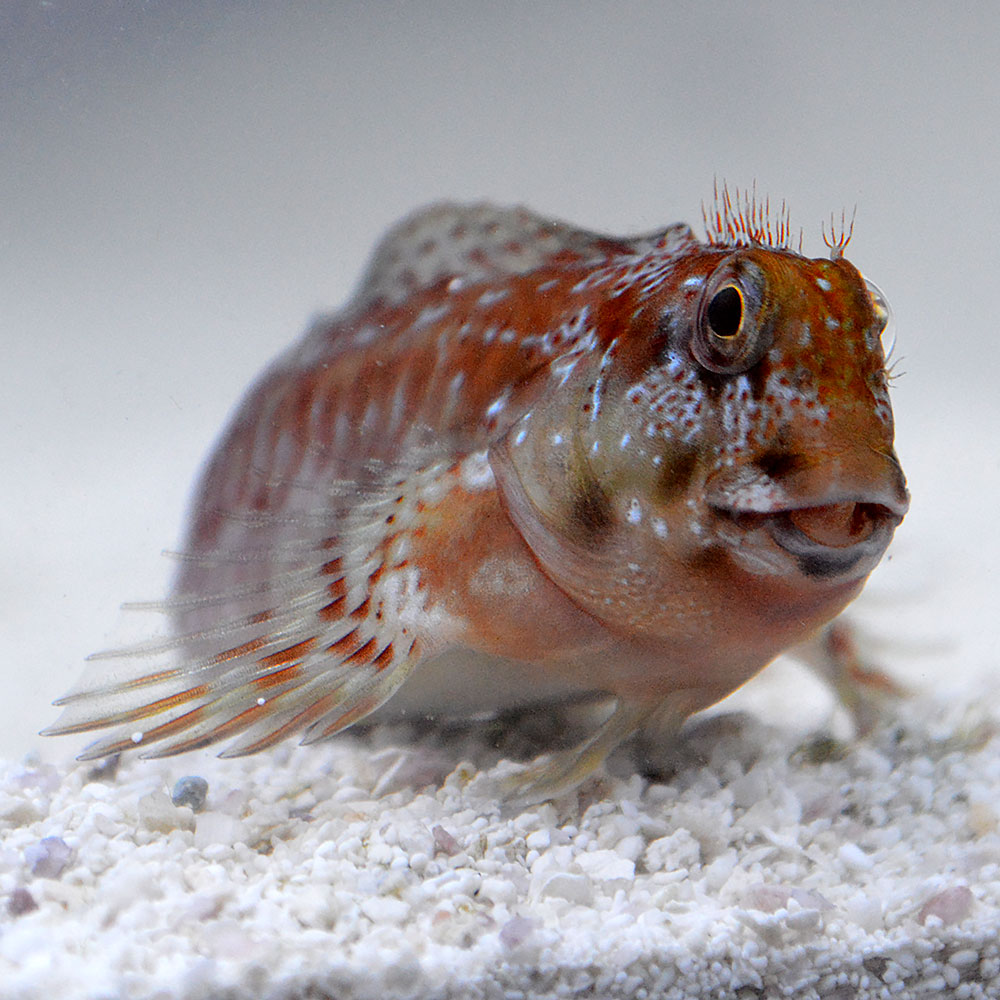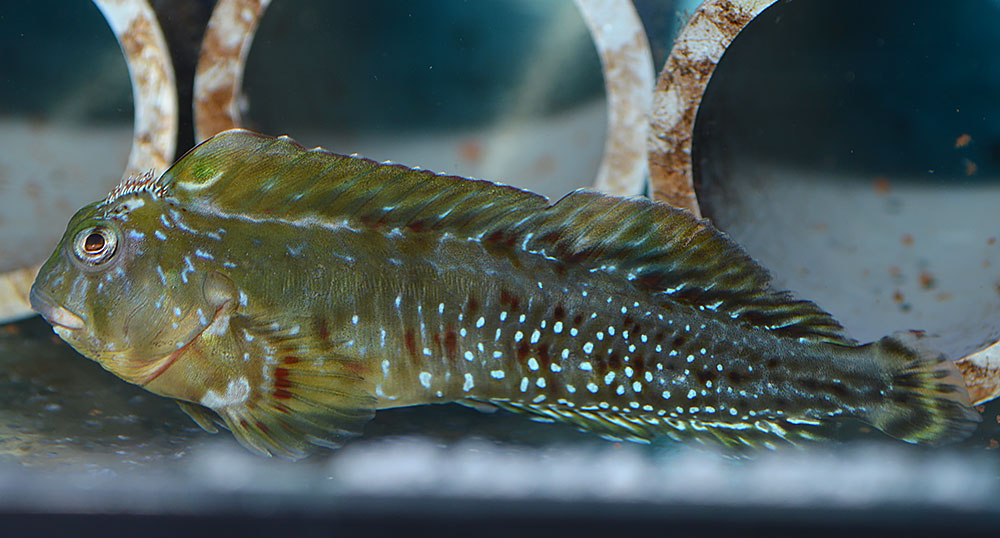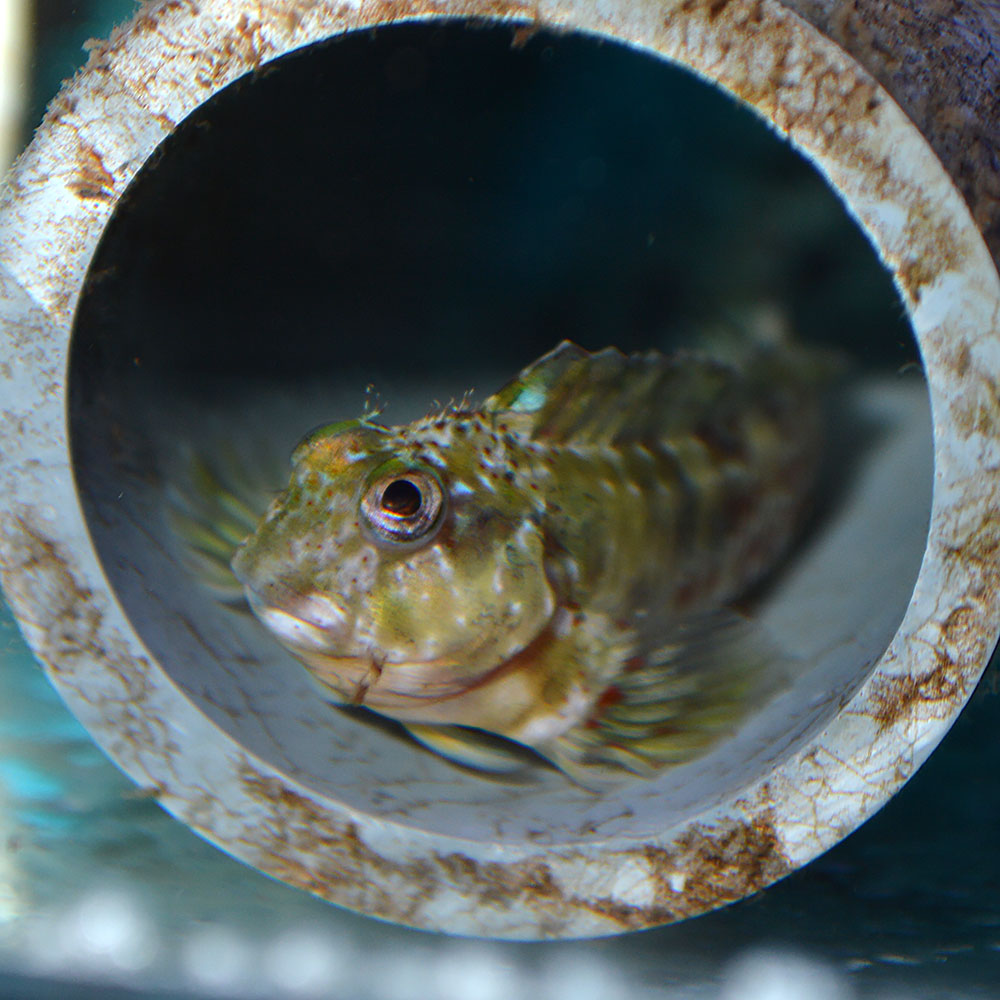The Molly Miller Blenny, Scartella cristata, is one of the many under-appreciated marine aquarium fishes. At first glance, its appearance might be considered drab. Cryptic, camouflage coloration that seems to blend together into “gray” from a distance seldom makes for the colorful addition so many of us want when we put a new fish into our reef tanks.
Then again, one look at a mature male (as shown above) should tell you that the unassuming juveniles do in fact have some potential to be rather attractive once they grow up. Their coloration is also influenced by their surroundings; they can be truly charcoal gray and completely ugly, or bright rusty red in the right conditions. Mood may also play a role in coloration; keeping them in social groups may make certain individuals more attractive.
Still, these aren’t gaudy reef fish, and there are plenty of freshwater fish that could give them a run for their money in the looks department. That’s not to say that an unassuming fish can’t be popular as a reef aquarium inhabitant; consider the popularity of the Lawnmower Blenny, Salarias fasciatus, which owes much of its popularity to its legendary capacity to graze down nuisance algae (as the common name clearly hints). Then again, one might even easily mistake a Molly Miller for a Lawnmower Blenny if they’re not paying attention.
A Captive-Bred Offering
In early 2012, Sustainable Aquatics announced the commercial scale propagation of Molly Millers for the aquarium trade, and they’ve been producing them ever since. Molly Millers earn a mixed reputation in terms of compatibility; they’re certainly boisterous Blennies. Watching them interact in holding aquaria, it’s a rather rough-and-tumble affair, and even in the 300-gallon reef aquarium at the Lake Superior Zoo, they love to cavort and chase each other through the rockwork.
In my personal experience, they seem far more interested in each other than in other fishes, but that’s with well-fed fish in group settings. Other aquarists report problems with Molly Millers becoming aggressive towards tankmates; this is certainly not a desirable trait for what’s supposed to be a “peaceful blenny” in your tank! Ironically, Lawnmower Blennies sometimes earn a similar reputation. Perhaps, after they’ve mowed down all the algae in the tank and are left with nothing, they need a Snickers (You’re Not You When You’re Hungry.™)
So why would anyone put up with a sometimes drab, potentially aggressive blenny?
Utilitarian Roles
Yes, Molly Millers are consummate grazers. We expect them to eat things like regular old algae, but as Kenneth Wingerter reported in Advanced Aquarist in 2012, they’re capable of doing a whole lot more than we normally expect from our janitorial blennies.
Wingerter wrote, “[The Molly Miller blenny] is known to feed on nuisance algae and detritus, and is widely reputed to feed on cyanobacteria and Aiptasia spp. sea anemones. If even half of these reports hold up to truth, the Molly Miller blenny could truly be the preeminent clean-up critter of the marine aquarium fish trade.”
Wait, did he just say they eat cyanobacteria and Aiptasia, two of the most noteworthy reef menaces out there? Further along in Wingerter’s article, a photo by Chris Turnier documents a small experiment that suggests that a single Molly Miller has vastly reduced the amount of detritus, cyanobacteria, and yes, Aiptasia, when compared to a vacant cube where no blenny had been introduced.
Come on…they really eat Aiptasia?
Aiptasia is the one problem that people really latch onto when it comes to this blenny. I think this has something to do with the fact that we ordinarily turn to certain species of Butterflyfish as biological controls for these pest anemones, but sometimes the Butterflyfish fail to thrive (e.g., Copperbanded Butterflies, Chelmon rostratus), or turn on desirable invertebrates. The same risks seem to hold true for the Bristletail Filefish, Acreichthys tomentosus, which at times can develop a taste for various LSP corals once its preferred anemones are depleted. Somehow, a captive-bred alternative in the form of a small blenny that seldom exceeds 4 inches (10 cm) in length makes a lot of sense to people.
Since I simply don’t have any Aiptasia (that’s not me bragging, just a statement of fact), I cannot say one way or another if there is truth to the claims that they eat Aiptasia. However, when turning to other aquarists, it seems there is replication of these claims.
Felicia McCaulley reported their Aiptasia-destroying abilities in her personal blog, Felicia’s Aquarium Adventures, in 2015, retelling her experience with Molly Millers while working at House of Fins in Greenwich, CT. “We started experimenting with our display tanks,” noted McCaulley. “I never actually sat still long enough to witness the Molly Millers eating an Aiptasia, but the tanks we put them in were clean within the week. Our maintenance team and customers started stocking their tanks with hordes of these fish. All raved about them.”
Reddit User Porkfish66 states that “My experience here is short, just started carrying them but so far feedback is good. They only seem to eat the small Aiptasia, however.”
Meanwhile, Altanta Reef Club member Spike suggests that maybe they’re not the viscious anemone killers we want them to be, reporting, “Each tank had a Molly Miller, a couple of clowns, and the Aiptasia rock. Three weeks later I still have 5-6 Aiptasia on each rock. The Molly Millers like to hang out on the rock and stare at the Aiptasia. Boy, if only looks could kill.”
Going back as early as 2006, the anecdotes mount with reports out of Texas via Reef Central: “All I know is that I had Aiptasia. I added these blennies. I have no more Aiptasia. I did nothing else to try to get rid of it. In my buddy’s tank, within 2-3 weeks of his blennies dying, he had Aiptasia again.”
The Jury Is Out
It seems likely that there is truth to the claims that Molly Miller Blennies will eat Aiptasia anemones; in fact, I’d say it’s looking pretty likely, and the info coming from sources I know and respect says that yes, they do.
However, while I could easily find videos of Copperbanded Butterflies, Peppermint Shrimp, Berghia Nudibranchs and even Bristletail Filefish, all eating pest anemones, no one’s documented it yet for the Molly Miller Blenny. So I’m putting it to you, the aquarist: if you have footage of a Molly Miller Blenny destroying some Aiptasia, upload it to YouTube or Vimeo and tell me about it! Then I can change the ending to this story and cite you as the clinching proof so many of us want!
In the meantime, you’ll have to enjoy these other interesting short videos of Molly Millers being the interesting blennies that they are.
Molly Miller munching algae, by Jose Guzman
Molly Miller Blennies being grown out at Sustainable Aquatics
Additional Reading
Sustainable Aquatics debuts captive-bred Allardi Clownfish and Molly Miller Blennies, by Matt Pedersen – https://reefbuilders.com/2012/04/09/sustainable-aquatics-debuts-captivebred-allardi-clownfish-molly-miller-blennies/
Aquarium Fish: Reconsidering the Molly Miller Blenny, by Kenneth Wingerter – http://www.advancedaquarist.com/2012/9/fish
Molly Miller Blennies eat Aiptasia and algae, by Felicia McCaulley – http://aquariumadventures.blogspot.com/2015/04/molly-miller-blennies-eat-aiptasia-and.html
Image Credits
All images by Matt Pedersen unless otherwise noted.






I have had a pair of Molly Miller blennies in a 120 gallon mixed reef tank for several years now. Haven’t seen them eat aiptasia anemones but have seen the female violently knock medium size (less than 1 inch) turbo snails from whatever substrate they were on. Then she waited for the overturned snail to come out of its shell to right itself, grabbed it by its foot, extracted it from the shell and ate it.
They produce babies frequently. Seems like almost constantly sometimes. They eat small to moderate quantities of nuisance algae in my tank, haven’t bothered any other fish, and are generally good community tank inhabitants. They feed aggressively on algae sheets and the usual meaty foods. Actually, they eat quite a lot for their size and you can forget about target feeding something like Elegance Coral a small piece of table shrimp. The female always takes it away. The male is charcoal black with many sky blue spots but he seems to always be incubating eggs and I rarely see him.
Though I’m very happy to add another aiptasia killer to our list of “can have” reef life, I’m surprised that there was no mention of another, more beautiful & super aggressive aiptasia killer… the Lemonpeel Angel. I keep these beauties in all my reef tanks as well as customer tanks with huge success… & have for many years. In most tanks I have them with other Pygmy Angel species (introduction is the key to success here) and also in tanks with clams. I have pictures that document this in succession for several years as well as thousands of people who have seen them here in person.
Would you be able to upload a picture of your male blenny please Mike? I have a mystery blenny that I’ve always just called an Algae Blenny. But I want to know what it truly is. He’s from Australian waters (where I live).
Hopefully you can see this image of him from my facebook profile – https://scontent.fmel1-1.fna.fbcdn.net/t31.0-8/12322770_10153745667720266_4557644239119211071_o.jpg
Dion – the first image in this article is presumably a male. Your fish is not a Molly Miller Blenny, but appears to be Istiblennius meleagris, the “Peacock Rockskipper” per Fishbase – http://www.fishbase.org/summary/Istiblennius-meleagris.html
That’s my fishy! Thanks Matt, didn’t know that resource existed.